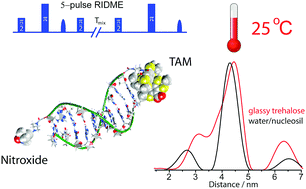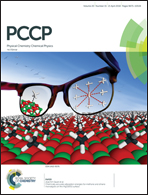Room-temperature distance measurements using RIDME and the orthogonal spin labels trityl/nitroxide†
Abstract
Electron paramagnetic resonance (EPR) based nanometer distance measurements at ambient temperatures are of particular interest for structural biology applications. The nitroxide spin labels commonly used in EPR reveal relatively short transverse relaxation under these conditions, which limits their use for detecting static dipolar interactions. At the same time, the longitudinal relaxation of nitroxide spin labels is still long enough to allow using them as ‘pumped’ species in the relaxation induced dipolar modulation enhancement (RIDME) experiment where the detection is carried out on the slower relaxing triarylmethyl (TAM) spin labels. In the present study, we report the first demonstration of room-temperature RIDME distance measurements in nucleic acids using TAM as the slow-relaxing detected species and traditional nitroxide as the fast-relaxing partner spin. Two types of immobilizers, glassy trehalose and the modified silica gel Nucleosil, were used for immobilization of the spin-labeled biomolecules. The room-temperature RIDME-based distance distributions are in good agreement with those measured at 80 K by other techniques. Room-temperature RIDME on the spin pairs trityl/nitroxide may become a useful method for the structural characterization of biomacromolecules and biomolecular complexes at near physiological temperatures.



 Please wait while we load your content...
Please wait while we load your content...